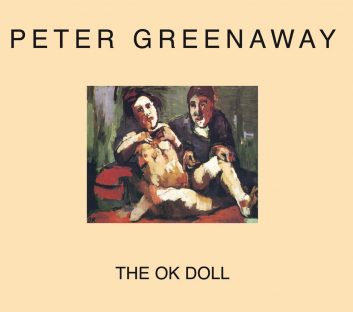 By PETER GREENAWAY (Dis Voir; 2014)
By PETER GREENAWAY (Dis Voir; 2014)
The idea of a man in love with a doll is hardly a novel one in cinema—see THE DOLL/VAXDOCKAN, LIFE-SIZE/GRANDEUR NATURE, LARS AND THE REAL GIRL, etc., etc., etc.—but in this unfilmed screenplay England’s Peter Greenaway creates a uniquely witty and perverse take on man-doll love. Why this script never made it to the screen I don’t know (whatever its flaws, it’s certainly no worse than certain Greenaway screenplays that did, such as THE BABY OF MACON and 8½ WOMEN), but it contains virtually everything we’ve come to expect from the brilliant, conceited and endlessly idiosyncratic Greenaway.
Spanning the years 1917-21 (as indicated by the dates provided at the head of each section), THE OK DOLL is set in Germany, where the aristocratic painter Oskar Kokoschka, referred to throughout as OK, resides. Finding himself unable to get over an affair he had with Alma Mahler (the widow of Gustav), he decides to create a fully functioning, anatomically detailed doll patterned on Alma—an early Twentieth Century sex doll, in essence—constructed by the woman’s dressmaker Hermine. With this doll OK, playing an elaborate game of pretend, seeks to right the perceived wrongs of his relationship with its flesh and blood namesake.
This entails a whirlwind romance, with sexual content that’s extreme even by Greenaway standards. Described are innumerable OK-doll trysts (a typical description: “We see him insert his erect penis into the doll’s vaginal cavity”) and even supporting characters having their way with the object, which exerts an unholy erotic fascination over OK’s friends and servants. But the core relationship inevitably goes as sour as that of OK and the real Alma, with OK growing increasingly abusive toward his nonhuman lover.
OK’s companions eventually create a doll of OK himself in an effort to shock him out of his delusional state. The attempt fails, with OK deciding he wants to impregnate his beloved Alma—whose inspiration had OK’s previous child aborted—thus necessitating the creation of yet another doll, and a most pertinent reckoning on the part of OK.
As a piece of writing THE OK DOLL leaves much to be desired. It being a screenplay, the descriptions are necessarily slapdash and perfunctory. Greenaway does attempt to provide an extra dimension, although I’m not sure that dimension would transfer too well to film; I wonder how Greenaway intended to visualize the sentence “OK thinks about both cities, and half wonders whether he ought to be in one of them, rather than here resting pleasurably after copulation beside a woman he does not love.” The trademarked Greenaway symbolism is carefully spelled out, with the Alma doll being “representative of the woman so many men loved to distraction,” while a scene set in a hall of mirrors entails the query “who is who, which is the reality and which is the mirror image?”
On that note, THE OK DOLL is perhaps most interesting as a quintessentially Greenaway-esque treatise on the lure of the artificial. It’s made clear at one point in the dialogue that OK’s pretend relationship with the Alma doll isn’t too far removed from the suspension of disbelief that occurs when one views a film, and it also recalls the deliberate artifice of many of Greenaway’s films (think of the play-like sets of THE COOK, THE THIEF, HIS WIFE AND HER LOVER and the interplay of the audience with the main action of THE BABY OF MACON). I’d argue that Greenaway’s love affair with the unreal reaches some kind of perverse apotheosis in this script, which for all its shortcomings would doubtless make quite a movie.
